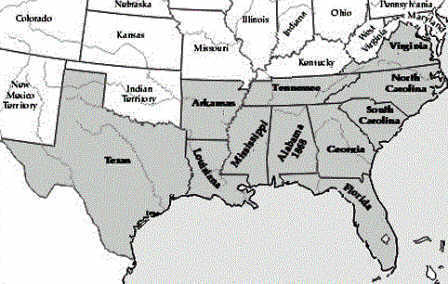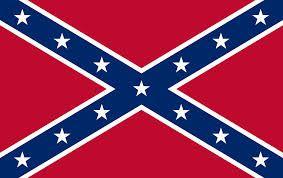Confederate States of America: Secession of the Southern States
The Secession of the Southern states took place within the borders of the formerly unified nation of the United States of America when 11 Southern states rebelled against the government, withdrew from the union, and declared their status as independent states and republics. The rebel states formed an alliance that was called the Confederate States of America (CSA), or simply the Confederacy - refer to the Causes of the Civil War. Confederate States of America: The 11 Southern States
What were the Confederate States? The Confederate States of America (CSA) consisted of 11 southern states that seceded from the Union in 1860 and 1861 before, or after, the inauguration of President Abraham Lincoln. The Confederate States of America, in order of secession, were South Carolina, Mississippi, Florida, Alabama, Georgia, Louisiana, Texas, Virginia, Arkansas, North Carolina and Tennessee. The first 7 states to secede from the union to form the Confederate States of America, took place before Abraham Lincoln took office on March 4, 1861. The 4 border states from the Upper South then seceded and were also admitted to the Confederate States of America (Virginia, Arkansas, North Carolina and Tennessee). The Confederacy later accepted two additional states (Missouri and Kentucky) as members of the Confederate States of America although neither of these states officially declared secession nor were they ever controlled by Confederate forces. Confederate States of America: Civil War (April 12, 1861 – May 10, 1865)
Abraham Lincoln believed that the United States was "one nation, indivisible". He went on to deny the Southern states' right to secede and the southern states were deemed to be in rebellion. No formal declaration of war was made but never-the-less the American Civil War was fought from April 12, 1861 – May 10, 1865 lasting 4 years, 3 weeks and 6 days of bitter, bloody conflict. | | List of Confederate States of America: Timeline
A list of the Confederate States of America and the dates of their secession from the union (in order of secession) are shown on the timeline: | Order of Secession | Dates of Secession | | 1 | South Carolina | December 20, 1860 | | 2 | Mississippi | January 9, 1861 | | 3 | Florida | January 10, 1861 | | 4 | Alabama | January 11, 1861 | | 5 | Georgia | January 19, 1861 | | 6 | Louisiana | January 26, 1861 | | 7 | Texas | March 2, 1861 | | 8 | Virginia | April 17, 1861 | | 9 | Arkansas | May 6, 1861 | | 10 | North Carolina | May 20, 1861 | | 11 | Tennessee | June 8, 1861 | | Order of Secession | Dates of Secession |
| Map of the Confederate States of America 
|
Confederate States of America: The Convention and the Constitution
The convention of the first seceding states was held in Montgomery, Alabama on February 8, 1861. The states agreed to form the Confederate States of America and, in only four days, wrote a provisional constitution for the Confederate States of America closely resembling the United States Constitution. The main differences between the constitutions were that the Constitution of the Confederate States of America made it completely clear that each member of the Confederacy was a sovereign state and that the institution of slavery would be protected in every way. The provisional Constitution of the Confederate States of America was replaced by the permanent constitution on March 11, 1861, which remained in effect until the end of the Civil War on May 10, 1865. Constitution of the Confederate States of America: Sovereignty
The members of the Confederate States of America believed that secession was a legal, constitutionally sanctioned act and that states, being sovereign, had the legal right to withdraw from the voluntary union with the United States of America. The Preamble to the Confederate Constitution reads: "We, the people of the Confederate States, each state acting in its sovereign and independent character, in order to form a permanent federal government, establish justice, insure domestic tranquility, and secure the blessings of liberty to ourselves and our posterity" Constitution of the Confederate States of America: Slavery
The Constitution of the United States of America made no mention of the word slave or slavery and used terms such as "Persons held to Service or Labour" but the Confederate Constitution used the words addressing the legality of slavery directly, and by name. Article I Section 9(4) stated that "No bill of attainder, ex post facto law, or law denying or impairing the right of property in negro slaves shall be passed." Article IV Section 2(1) went on to say that "The citizens of each State shall be entitled to all the privileges and immunities of citizens in the several States; and shall have the right of transit and sojourn in any State of this Confederacy, with their slaves and other property; and the right of property in said slaves shall not be thereby impaired." Government of Confederate States of America: President and Vice President
Who was the president of the Confederate States of America? Jefferson Davis (June 3, 1808 – December 6, 1889) of Mississippi was chosen as the president of the Confederate States of America, and Alexander H. Stephens was chosen as the vice-president. Jefferson Davis formed his first cabinet consisting of Robert Toombs as Secretary of State, Christopher Memminger as Secretary of the Treasury, LeRoy Pope Walker as Secretary of War, John Reagan as Postmaster General and Judah P. Benjamin as Attorney General. Jefferson Davis was the President of the Confederate States of America from February 22, 1862 to the end of the Civil War on May 10, 1865 however, the members of his cabinet were frequently changed. Confederate States of America
The new government of the Confederate States of America seized or pressed its claims for United States property within its domain, especially forts, armories and arsenals. The Union refused to surrender Fort Sumter situated on Charleston Harbor and ordered the firing that formally began the hostilities of the Civil War between the United States and the Confederate States of America. | | Confederate States of America Flag 
| The Confederate States of America Flag
There are several different flags used by the Confederate States of America but the flag pictured opposite is the best known. But why did the Confederate flag have 13 stars? The Confederate States of America consisted of 11 states but the acceptance of Missouri and Kentucky brought the total to 13 states. This number is therefore reflected in the Flag of the Confederacy commonly referred to as the "Southern cross flag", "Confederate Flag" or the "Rebel Flag" and has become a widely recognized symbol of the South and explains the significance of the 13 stars displayed on the Saint Andrew's Cross design. |
|